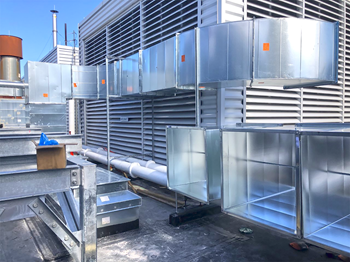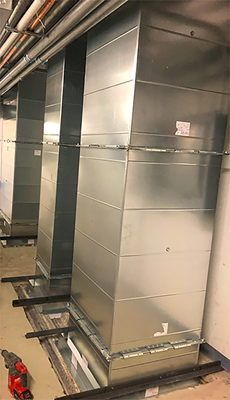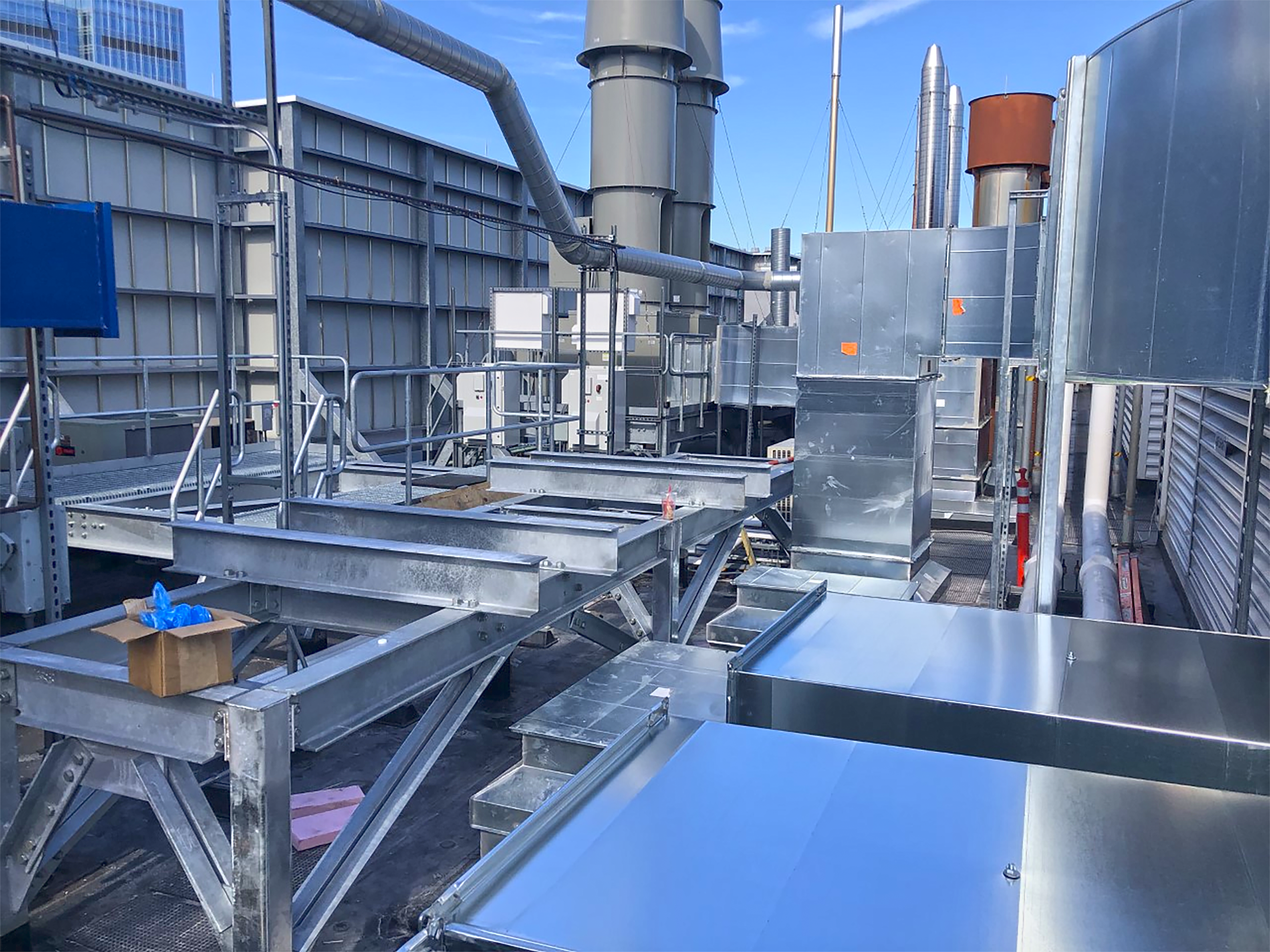

New roof ductwork was installed before being connected to the fans.
Sean O’Keeffe and his colleagues at JEC Service Company, Inc. have done a lot of laboratory HVAC projects over the years. Hospitals, universities, biotechnology companies, and many pharmaceutical clients highlight this Waltham, Mass.-based SMACNA firm’s construction portfolio.
Understanding the complexities of these highly specialized lab HVAC systems meant O’Keeffe, a project manager with JEC, wasn’t worried about an HVAC fit out of a new pharmaceutical laboratory in Cambridge. It was a facility where he’d done HVAC work before, so he expected there would be some challenges that typically come with retrofit construction.
Then came the unexpected.
COVID-19 cases exploded across the U.S., causing the City of Cambridge issued a construction moratorium on March 21, 2020.
“We had only completed the demo prior to the shutdown,” O’Keeffe recalled. As most successful business do, JEC adapted. They also benefitted from a little luck.
After just a couple weeks delay, the Binney Street project was exempted from the moratorium. The lab fit out was determined to be essential construction work, since the client/tenant would be working to develop new techniques for targeting infectious diseases.
“I had two jobs in Boston that were shut down and did not open back up until the city ended the construction moratorium,” O’Keeffe said. “Another pharmaceutical job in Framingham (Mass.) also got an exemption status.”
The scope of work for the 42,000 square foot Binney Street project was to install new medium and low-pressure supply distribution ductwork for two existing 20,000 CFM air handling units and a couple 100% outside air handling units. Exhaust ductwork included new risers for various fans, including dedicated biosafety fans and specialized rooftop fans.
JEC was able to be productive during the shutdown, as they had recently begun doing more prefab work in their shop. They expanded that practice for the Binney Street project, fabricating 15-foot sections of duct that could be delivered to the job site later.
“Once COVID (restrictions were lifted and job sites) opened back up, we went on site and all the trades started flying again. We were able to keep pace because we had done all this work ahead of time,” O’Keeffe said. “Just like everyone, we were anxious about going back out to the field, but also eager to get out there to do what we felt was our part to help out.”
Back on the job site, O’Keeffe was able to enjoy the ‘normal’ challenges of customizing advanced HVAC systems that enable precise control of temperature, humidity, filtration, and pressurization. O’Keefe said he likes doing that work a lot, even when they encounter preexisting lab waste, which is not unusual. At the Binney Street project, the ceilings above the laboratory were congested with piping and duct from an upstairs tenant.

New risers being installed at the facility.
“It’s a much slower process than a typical job,” O’Keeffe said. “It was just everywhere, and it wasn’t documented.”
“A lot of times we weren’t able to coordinate around it, so we ended up getting a 3D scan of the floor,” he said. “I think they used a Trimble 3D scanner machine to give all the coordinators a 3D model of all the existing things that were there. The 3D scan became very important in that month that it was shut down.”
With visual data from the 3D scan, JEC was able to install every part of the custom designed HVAC system. O’Keeffe said the medium pressure supply mains were 66x30 and the new risers were 50x30. Here are some project highlights:
- 2 air cooled condensing units
- 2 Mitsubishi air conditioning units
- 63 variable air volume (VAV) supply air boxes
- 40 variable volume exhaust (VVE) boxes
- 8 variable frequency drives
- 4 tubular inline high plume upblast biosafety exhaust fans
- 2 general exhaust fans
- 2 relief fans
- 4 Strobic roof mounted exhaust fans
- 63 hot water coils, and some refrigeration piping
Ultimately, JEC was able to finish the $2.35 million job on schedule in November. O’Keeffe attributes JEC’s success to the team, and the company’s presence in a wide variety of markets.

Images of JEC’s coordination drawings illustrate where lab work is extra congested.
“Our diverse construction portfolio was a huge help in surviving this year,” he said.
“Everyone in the company really did their part to keep things moving in an efficient way. It hasn’t been easy for anybody, but understanding that we are all getting through the ever-changing restrictions and guidelines as a team makes it a lot more manageable.”
O’Keeffe did find another unexpected effect of the COVID-19 pandemic, but this promises to be good news. New and existing clients have been contacting JEC about improving indoor air quality, to help mitigate infection concerns.
“I have been pricing a lot of jobs to change out rooftop equipment to increase the amount of fresh air in the buildings,” he said. “On the service side, we have been working with some of our customers on guidelines that were issued by ASHRAE.”
